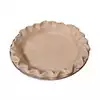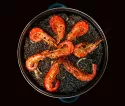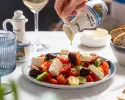Salmon Niçoise Pasta Salad

You can never have too many main course recipes, so give Salmon Niçoise Pasta Salad a try. This recipe covers 31% of your daily requirements of vitamins and minerals. One serving contains 833 calories, 31g of protein, and 53g of fat. This recipe serves 4. A mixture of salmon fillet, garlic clove, shell, and a handful of other ingredients are all it takes to make this recipe so tasty. To use up the salt you could follow this main course with the Apple Turnovers Recipe as a dessert. From preparation to the plate, this recipe takes roughly 45 minutes. It is a good option if you're following a dairy free and pescatarian diet.
Instructions
1
Sprinkle salmon with 1/4 teaspoon salt and 1/4 teaspoon pepper.
Ingredients you will need![Pepper]() Pepper
Pepper![Salmon]() Salmon
Salmon![Salt]() Salt
Salt
2
Heat 2 teaspoons oil in a large nonstick skillet over medium-high heat.
Ingredients you will need![Cooking Oil]() Cooking Oil
Cooking Oil
Equipment you will use![Frying Pan]() Frying Pan
Frying Pan
5
Meanwhile, cook pasta according to package directions, adding beans during last 4 minutes of cooking time.
Ingredients you will need![Beans]() Beans
Beans![Pasta]() Pasta
Pasta
Equipment
Ingredients
1teaspoons![freshly ground black pepper, divided]() freshly ground black pepper, divided3Tbsps
freshly ground black pepper, divided3Tbsps![capers, drained]() capers, drained1teaspoons
capers, drained1teaspoons![Dijon mustard]() Dijon mustard1
Dijon mustard1![garlic clove, chopped]() garlic clove, chopped237milliliters
garlic clove, chopped237milliliters![cherry or grape tomatoes, halved]() cherry or grape tomatoes, halved296milliliters
cherry or grape tomatoes, halved296milliliters![ounces green beans, cut into 2-inch lengths]() ounces green beans, cut into 2-inch lengths79milliliters
ounces green beans, cut into 2-inch lengths79milliliters![niçoise or kalamata olives, pitted and halved]() niçoise or kalamata olives, pitted and halved59milliliters
niçoise or kalamata olives, pitted and halved59milliliters![olive oil]() olive oil2teaspoons
olive oil2teaspoons![olive oil]() olive oil59milliliters
olive oil59milliliters![chopped fresh Italian parsley]() chopped fresh Italian parsley591milliliters
chopped fresh Italian parsley591milliliters![ounces shell or other short pasta]() ounces shell or other short pasta59milliliters
ounces shell or other short pasta59milliliters![thinly sliced red onion]() thinly sliced red onion2Tbsps
thinly sliced red onion2Tbsps![red wine vinegar]() red wine vinegar454grams
red wine vinegar454grams![salmon fillet]() salmon fillet1teaspoons
salmon fillet1teaspoons![salt, divided]() salt, divided
salt, divided
 freshly ground black pepper, divided3Tbsps
freshly ground black pepper, divided3Tbsps capers, drained1teaspoons
capers, drained1teaspoons Dijon mustard1
Dijon mustard1 garlic clove, chopped237milliliters
garlic clove, chopped237milliliters cherry or grape tomatoes, halved296milliliters
cherry or grape tomatoes, halved296milliliters ounces green beans, cut into 2-inch lengths79milliliters
ounces green beans, cut into 2-inch lengths79milliliters niçoise or kalamata olives, pitted and halved59milliliters
niçoise or kalamata olives, pitted and halved59milliliters olive oil2teaspoons
olive oil2teaspoons olive oil59milliliters
olive oil59milliliters chopped fresh Italian parsley591milliliters
chopped fresh Italian parsley591milliliters ounces shell or other short pasta59milliliters
ounces shell or other short pasta59milliliters thinly sliced red onion2Tbsps
thinly sliced red onion2Tbsps red wine vinegar454grams
red wine vinegar454grams salmon fillet1teaspoons
salmon fillet1teaspoons salt, divided
salt, dividedRecommended wine: Chardonnay, Pinot Noir, Sauvignon Blanc
Salmon works really well with Chardonnay, Pinot Noir, and Sauvignon Blanc. To decide on white or red, you should consider your seasoning and sauces. Chardonnay is a great friend to buttery, creamy dishes, while sauvignon blanc can complement herb or citrus-centric dishes. A light-bodied, low-tannin red such as the pinot noir goes great with broiled or grilled salmon. You could try Foley Estate Winery Sta. Rita Hills Chardonnay. Reviewers quite like it with a 4.3 out of 5 star rating and a price of about 27 dollars per bottle.

Foley Estate Winery Sta. Rita Hills Chardonnay
Rancho Santa Rosa Vineyard was originally conceived as individual micro-vineyards delineated into 59 unique blocks based upon soil, exposure, elevation, grade, rootstock and clone. Rancho Santa Rosa produces remarkably rich and silky wines.DifficultyHard
Ready In45 m.
Servings4
Health Score47
Dish TypesSalad
Related recipes
Warm Szechuan Shrimp and Spinach Salad
Pineapple Couscous Salad
Fruity Apple Salad
Red, White and Blue Slaw Salad
Magazine

Your Inner Chef with Taylor Swift's Top 3 Recipes from Her Beloved NYC Hangout

20 Mouthwatering Recipes You Need to Try Today!

Master the Art of Making Perfect Pancakes with This Foolproof Recipe

The Science Behind Red Wine: Its Surprising Health Benefits and Potential Risks

12 Wine Cocktails for a Sophisticated Twist

Sip, Swirl, and Celebrate: Toasting to National Wine Day on May 25th

National Drink Wine Day on February 18

Celebrating Souffle Day with Delectable Delights

Indulge in the Delightful Flavor of Oyster Soup on Its Special Day!

Celebrating World Nutella Day

10 Foods that Relieve Constipation Naturally

Indiana's Exciting Addition to the Summer Food Program for School Children

Artichoke Tomato Pesto Flatbread Recipe A Scrumptious Twist on Savory Classics

10 Lucky Recipes for Wealth and Success

From Ropa Vieja to Mojitos Traditional Cuban Cuisine

From Tapas to Paella Authentic Spanish Cuisine

Beyond Gyros and Feta Food Culture of Greece

Uncover the Secrets of Lip-Smacking Recipes for Outdoor Cooking

A Quick and Easy Guide to Cooking Fast Food at Home











